At their core, succulents are sun-loving plants.
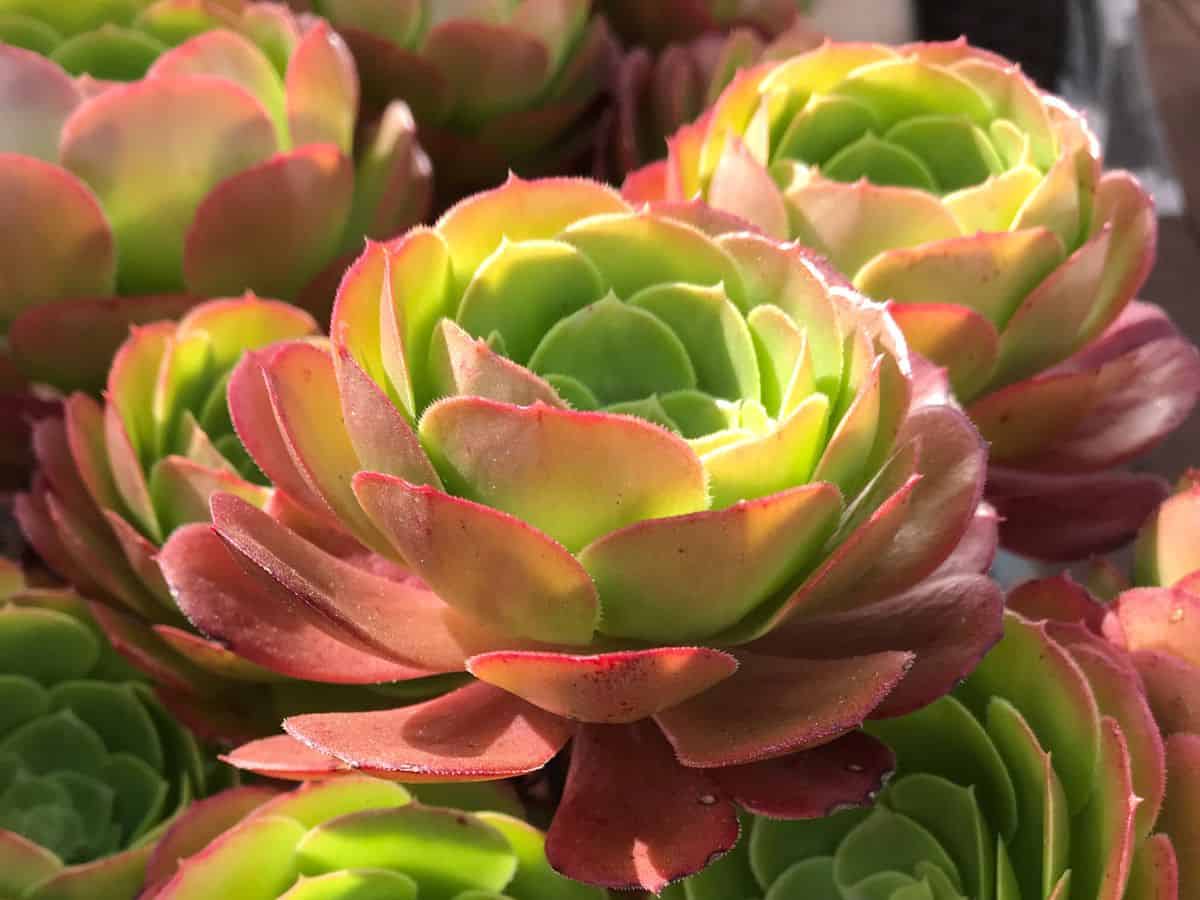
And that’s good a thing - it’d be pretty hard to survive in those arid and desert environments without an appreciation for sunshine.
However, the lighting needs of succulents and cacti are a little more nuanced than just placing them on a windowsill. There are a lot of factors to consider, especially if you want those Instagram-worthy pictures.
Jump to:
How Much Light to give Succulents
Light is a funny thing since it’s hard to measure.
You can pour 1 cup of water on a plant or add 1 tablespoon of perlite to a soil mix, but it’s not like you can give a plant 7 lbs. of organic, free-range light every day.
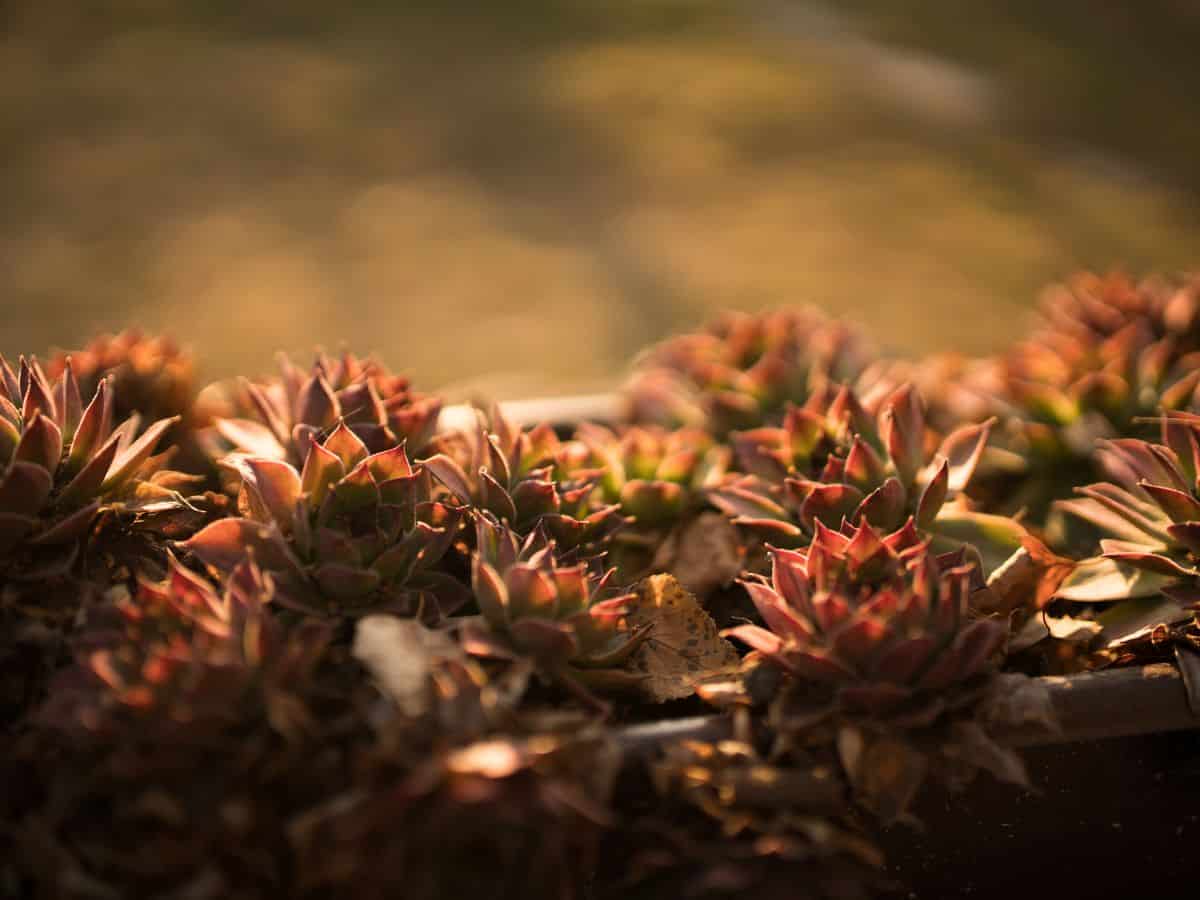
The best approximation we have is to simply measure duration. How long should the succulent be exposed to light each day?
And to further complicate things, how much of what kind of light? There’s natural and artificial, morning and afternoon, and fluorescent, etc. It gets pretty confusing.
But we’re here to simplify things, so let’s start with a baseline: Succulents like to have about 10-14 hours of light a day.
That’s assuming, of course, that it isn’t a shade-loving succulent like Sansevieria trifasciata (the Snake Plant). They would fry with that much light.
Why not more light? Why not 24 hours-a-day light? Because plants need rest too!
And I mean that seriously – just like people need to sleep to do important things like reset our brains and repair our muscles, plants have certain processes that only occur in the dark.
In fact – here’s some fun trivia. Succulents especially need the dark. Most of them use a special kind of photosynthesis called CAM. Those plants only take in carbon dioxide during the night and store energy during the day.
I wouldn’t wanna hold my breath for 24 hours, would you?
So definitely don’t expose your plants to more than 14 hours. 12 hours of light a day is enough to make anyone happy.
And, certainly, succulents and cacti can and do survive with less light. That’s a risky proposition, though, because it results in etiolation.
Etiolation
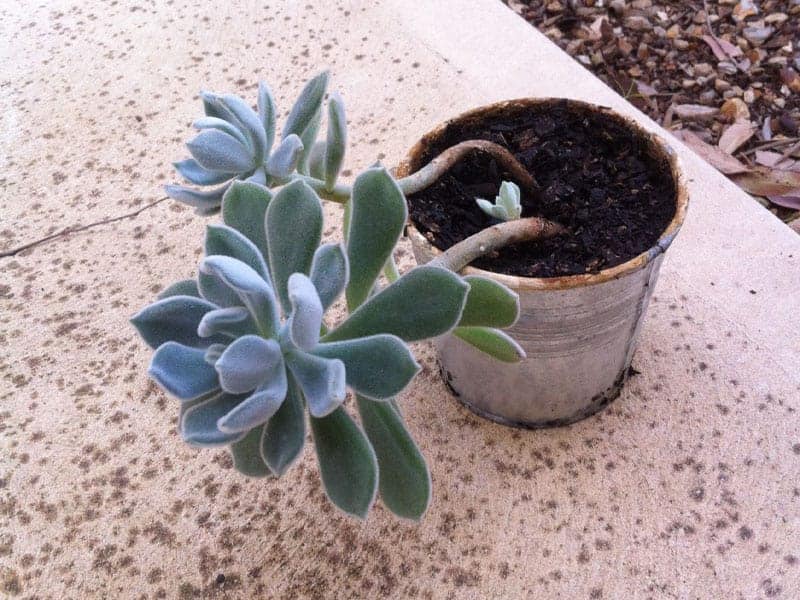
Etiolation, also known as ‘stretching’ or a plant becoming ‘leggy’, is a neat example of plant behavior in action.
What, you thought only animals had behaviors?
Nope! It’s intuitive, so you probably never thought about it this way, but plants know where light is coming from and how to get there.
So they lengthen some cells, shorten others, and bend and twist their way towards the light source. They grow their stem/trunk/branches toward light very rapidly.
Usually, the plant slows or stops the production of leaves during the etiolation process. That makes sense – there’s not enough light anyway, why bother?
The result of etiolation is… well, it’s not pretty. Your succulent will probably look like a gangly, pubescent 13-year-old. It might even be top-heavy and in danger of falling over and being damaged.
While the plant is ugly now, it’s important to know that it’s not unhealthy. Plants in the wild grow etiolated all the time while shaded. As soon as it gets to that sweet spot of light, the plant will resume regular growth.
The bad news is that etiolation is not reversible. Once a succulent, or any plant, has grown all stretched-out, that’s how it will be for the rest of its life.
It’s not like they can reverse-grow, you know? That’s called dying.
Buuut, there’s good news too! We’re dealing with succulents and cacti; a hardy group beloved for easy propagation. You can “fix it” by growing a new plant, kinda.
Take an etiolated Echeveria for example (and they are always etiolated). It gets long and skinny with sparse leaves and a bare stem when etiolated. You can behead the succulent (cut it an inch below the rosette at the top), let it callus over a couple of days, then stick it back in the dirt.
If you give it enough light this time, it’ll grow (slowly at first) into a normal-looking Echeveria!
As a bonus, the other half will probably start to regrow some new rosettes – even if you didn’t leave any leaves on it!
This beheading method works best on rosette-type succulents but can be applied broadly to most groups.
Seasonal Light Differences
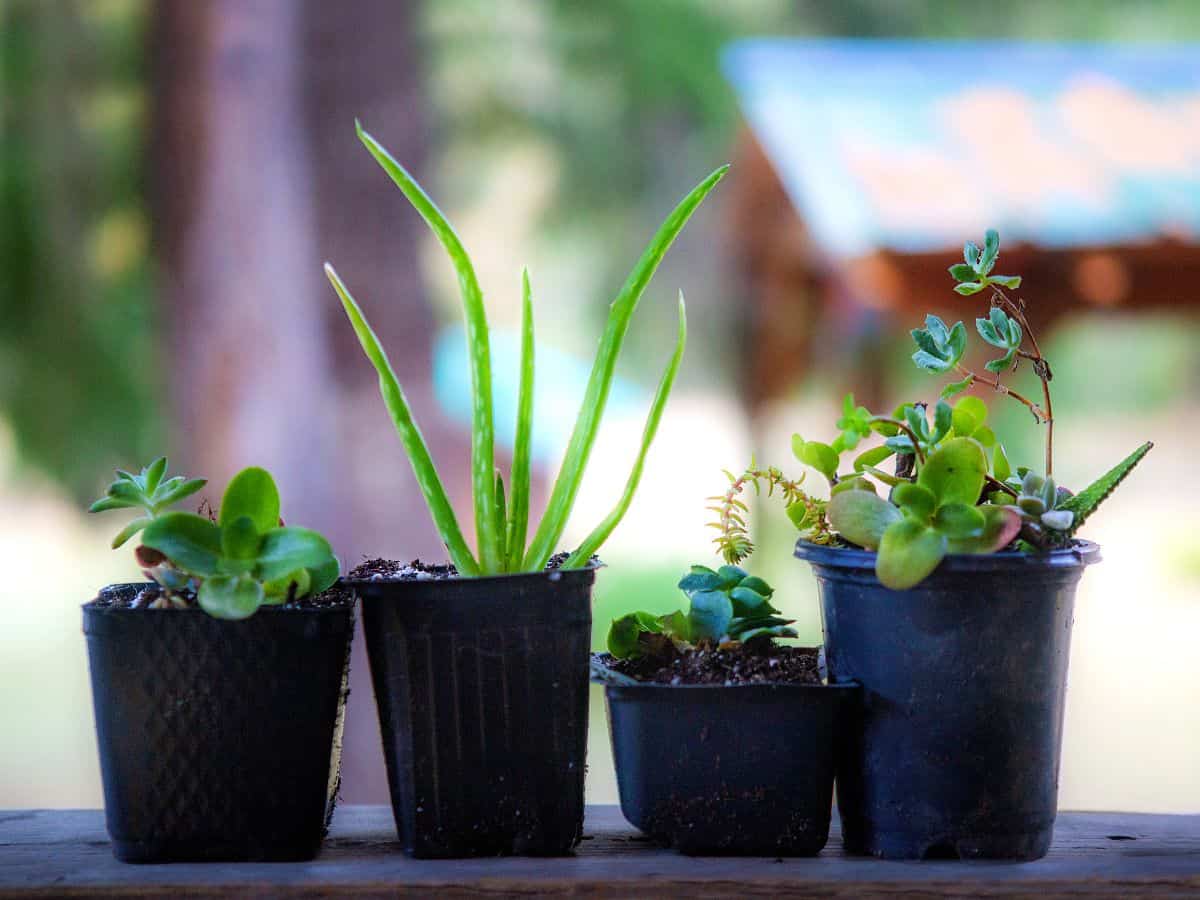
It hardly needs to be said, but the levels and intensities of light differ from season to season.
Summer days can get pretty long, and the light is pretty strong too. Most succulents thrive in these conditions, but if you live in an area that is known for extreme summers, you might want to take some precautions to protect them.
Winter days are shorter with less intense light. If your succulent happens to be dormant in winter, that’s awesome. If not – it might need to be supplemented with more light than it would otherwise get while sitting on a windowsill.
Some people rotate their succulents and cacti indoors and outdoors as the seasons change. The plants will doubtless love the bright sun during the summer, but most succulents can’t endure temps below freezing.
Sunlight vs Artificial Light
This is a big topic; I could probably write a whole book on just this question alone!
It’s a particularly interesting comparison, too. A lot of science comes into play (sorry), but also a fair bit of personal preference.
No products found.
Neither sunlight nor artificial light is better than the other. There are situations where one outshines (get it?) the other, but they’re both valuable tools for any succulent grower.
Sunlight
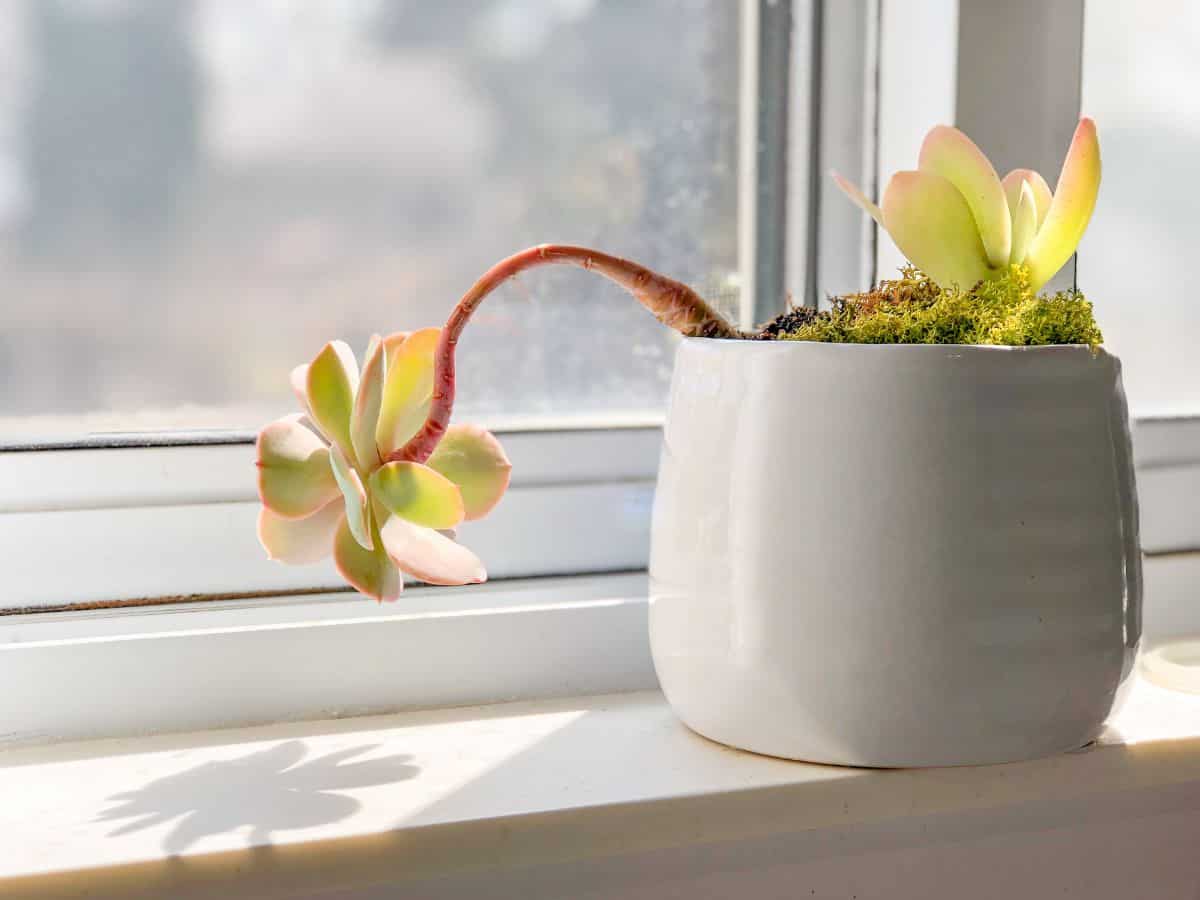
Sunlight is amazing because it’s right there and it’s free! Seriously, you can just put succulents on your windowsill and water them when you remember to and they’ll thrive. It’s great!
There’s something to be said for that big, blazing ball of fire hanging in the sky. It’s been there for a few billion years. All life on Earth is equipped to handle it, and in the case of plants and succulents especially, to harness it.
Succulents were born to bathe in sunlight. They have crazy colors that enable them to absorb different wavelengths and amazing adaptations to protect themselves and to channel that sunlight.
It’s never the wrong choice to give your succulents light from the sun.
Maximizing Natural Light Indoors
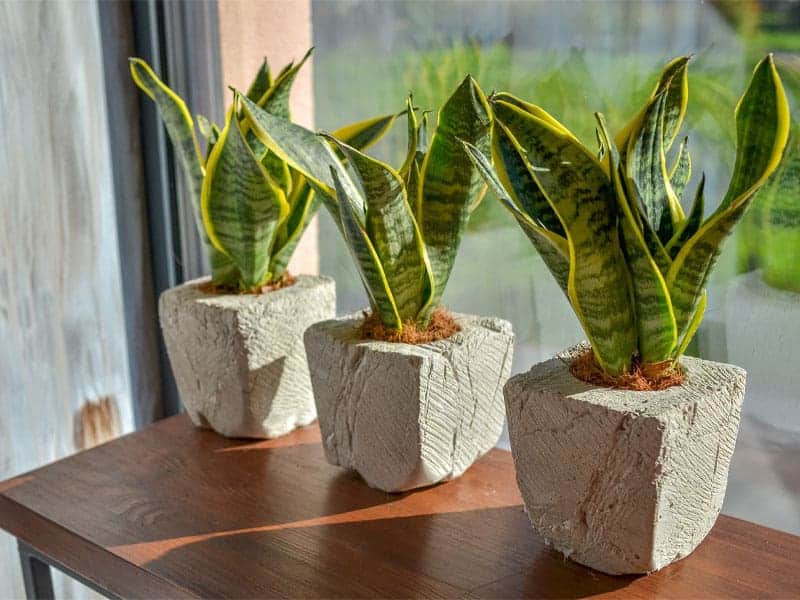
Natural light waxes and wanes as the day progresses, and as seasons progress.
That natural cycle works out really well for succulents and cacti – the morning through midday light is often very intense, and it tapers off in the afternoon.
For those of us in the northern hemisphere, a south-facing window provides the best light. It has more hours of daylight than any other direction. Conversely, north-facing windows have the least.
In regard to east and west windows, you should prioritize placing plants in windows facing east. The sun rises in the east and the strongest sunlight is in the first half of the day. West windows (and north windows) work really great for plants that prefer partial sun.
Obviously, you’ll want to take into account external factors such as trees or buildings that will cast shade on your windows. And place your plant as close to the glass as you can – every inch means more light and happier cacti.
Keep that glass clean, too! Windows already block or diffract a significant amount of light and any accumulated grime can really cut down on the light getting through.
Mirrors are surprisingly effective at bouncing light around and magnifying the effect of natural light. A mirror near the window will have a substantial impact on the light in the room and on your plant.
When you inevitably run out of space in all your good windows, consider getting a windowsill shelf or hanger. They easily double or triple the space in your best real estate.
Sun-Stress or Sun-Blush
This is one of the coolest parts about succulents – some change colors in the sun!
It’s called by a couple of names, but I usually call it sun-stress because it’s a more accurate description of the process. Some succulents, if exposed to intense sunlight and UV light, will begin to change color. It’s a defensive measure to mitigate the impact of the harsh solar energy.
They’re not in any danger when sun-stressed. In fact, it’s an indicator that they’re probably pretty healthy!
You might have noticed that the plants you’ve bought online weren’t quite the same color as the pictures or started to fade after a couple of weeks.
All of those gorgeous orange and blue and purple succulents you see on Pinterest have been exposed to lots of light, otherwise, they would probably be green too.
Here's a hybridAloe commonly called Christmas Carol Aloe.
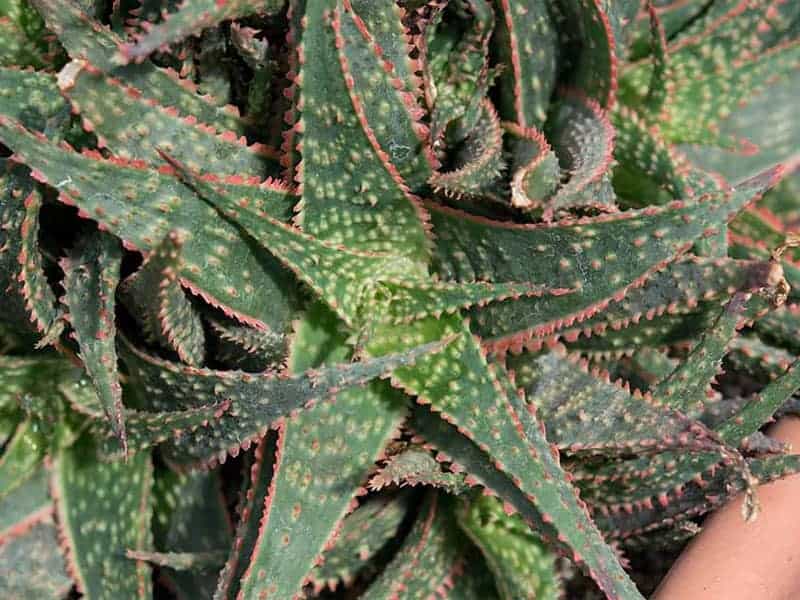
Here's another Christmas Carol Aloe that's been exposed to full sun.
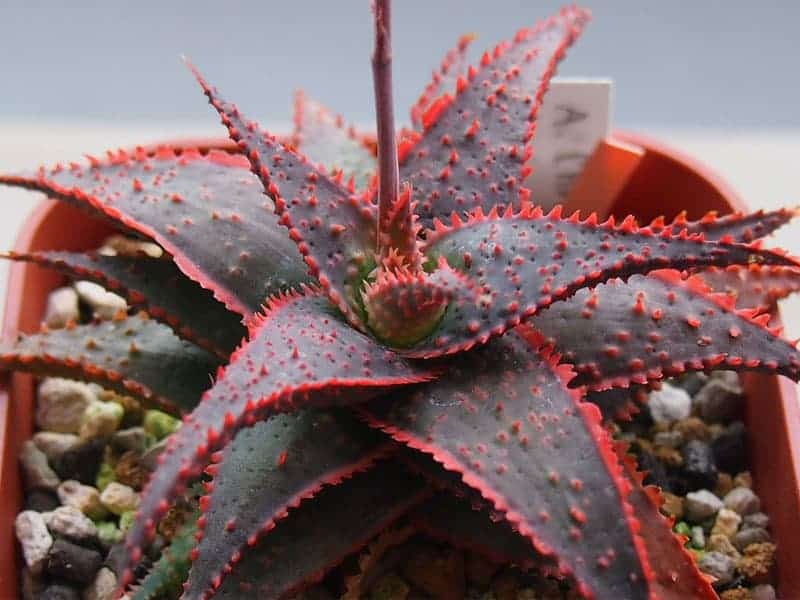
If you want your succulents and cacti to have that brilliant coloration, it’s as simple as sticking them out in direct sunlight. After a couple of weeks, you should see their true colors come through (if they are indeed a color-changing variety).
It’s possible to get the same pretty colors with artificial light, but generally more difficult. The intensity of the light, as well as light from the UV-part of the spectrum, is responsible for the change.
You’d have to go out of your way to replicate UV light, and intense light is generally not a feature of artificial lights. Full-spectrum bulbs do a decent job of replicating sunlight – so those would be your best bet.
Sunburn
Plants can get sunburned too, you know!
Succulents are pretty resistant to sunburn, more so than other plants, but they can still get burnt. It’s generally only an issue in a couple of situations.
Some succulents just can’t handle the heat. The shade-loving ones are particularly susceptible. Strong, direct light for many hours could cause them to burn.
If you’re watering plants and leave water drops on the leaves, they might act as a magnifying glass and amplify strong sunlight – causing the plant to burn. It’s usually not an issue, but you should try to water at the base of the plant just in case.
Some succulents, many Echeveria especially, have a fascinating adaptation called “farina”. Farina is that powdery white substance on leaves that smudges when you touch it. That stuff is actually a sort of natural sunscreen that protects from intense light, so you should probably avoid getting too handsy.
What does a succulent sunburn look like?
On most plants, sunburn manifests as a light browning on the leaves that can quickly turn severe if it doesn’t get some relief. It usually starts around the edges and those get crispy pretty quickly once the process starts.
Occasionally, sunburn will appear as small brown spots (especially if water drops were left on the leaves).
Leaves curling is another indicator that the plant is getting loads of sun and is at risk of being burned.
Sunburn isn’t too hard to avoid, though it can be tedious. Most succulents and cacti can take a full day of intense sun… assuming they’re acclimated.
Acclimatization is a gradual process. If a plant has been indoors or in lots of shade for a while, it’s become used to those conditions. Moving it into the harsh sun all at once is a recipe for disaster.
Over the course of a couple of weeks, give the plant more light every day. Whether that means moving it to a place with less shade or taking it inside and outside repeatedly, the plant should experience more duration and more intensity of light each day.
You can use shade cloths of varying thicknesses for this process, too!
Artificial Lights

Natural light is great, but artificial lights have a lot going for them too!
If you’re like me, you ran out of windowsill space a long time ago. Light doesn’t penetrate deep enough into a house to power succulents that aren’t sitting next to the window.
And if you live in any place that has a cold winter, most succulents can’t hack it outside. They’ll have to come in for a few months at least. They’ll still need light inside, of course, otherwise, they run the risk of etiolation or even death.
Artificial lights are also pretty great for propagating since they aren’t too intense. Specific wavelengths of light can even be used to encourage flowering or fruiting.
They’re not free, unfortunately, in terms of the bulb or your electricity bill. The upfront investment is generally pretty low, though, and it allows you a lot of freedom in your plant placement.
A Guide to Cactus Grow Lights

Jumping into the world of grow lights (also called grow lamps) can seem daunting, but it’s not really that complicated.
There are a few different kinds of lights, and they come in a few shapes. Choosing one is as simple as identifying your needs and picking the right match.
If you'd like more info, we have a guide specific to them here.
Incandescent
Incandescent light bulbs are great… if you’re still living in the 1950s.
The average incandescent bulb only converts about 2% of the electricity it receives into the light. The other 98% of the energy is released as heat.
That’s not very energy-efficient, nor do they make very much light. All-in-all, pretty useless for our purposes as a grow light.
So, we’ll skip incandescents in favor of our more modern alternatives.
Fluorescent
These are the bulbs you encounter most often in your daily life. That bright white light is unmistakable.
Most of the fluorescent bulbs you use are probably in the form of a long tube. These tubes come in different standard dimensions. Some of the more popular formats for grow lights are T5 and T8, and occasionally T12.
For home-growers and hobbyists, T5 is the way to go. These are smaller and more compact than their larger-numbered brethren. T5 comes in several lengths, but the one and two-foot varieties are most common.
Not everyone has a need for long tube light, though. Maybe you only need to illuminate one plant or don’t want to go through the trouble of suspending a light.
For those people, the CFL bulb was invented.
You’ve seen CFL bulbs too – they’re shaped much like the classic incandescent lightbulb. They fit into regular light bulb sockets (unlike the tube lamps) and can be integrated into existing lamps.
I like to replace the lightbulbs on my desk with CFL bulbs so I can keep succulents next to my computer 🙂
LED

LEDs, or Light-Emitting Diodes, are (relatively) new lighting technology. They bring some pretty neat advantages to the table.
The first thing to know is that they are extremely energy-efficient compared to the other kinds of light bulbs. They produce very little heat and lots of light, all while using minuscule amounts of electricity.
Another cool thing about LEDs is that, depending on the materials used in the construction, you can get them to emit a very narrow band of light. For our purposes that means they’re even more energy-efficient since you can choose to use just red and blue LEDs (the primary wavelengths of light that photosynthesis occurs at).
Using those specific wavelengths lets you do some cool stuff. Red light, for example, is an important trigger in the flowering process for many plants. Using lots of red LEDs might encourage your succulent to flower. Blue light is important for stimulating vegetative growth.
LEDs are super small, too, which means they can be used in a lot of ways. They come in tube and CFL varieties if you want to replace your existing fluorescents with LED. They also come spooled up on long strips – you can use LED strips (or LED tape) to illuminate a space you wouldn’t be able to fit a tube or bulb into.
For an imaginative person, LEDs can open a lot of doors!
Positioning Grow Lights
In their haste to set up grow lights, a lot of people overlook one of the most important aspects of grow lights – where do you put them.
For most grow lights, the optimal position is 6-10 inches above your succulents.
Does that seem awfully close? It is pretty close, but there’s a reason.
Most of those lightbulb formats we discussed actually emit light in a 360-degree, or sometimes 180-degree, arc. If your plants are directly beneath the light, that means most of that wonderful light energy is being wasted. Your plant only occupies a small sliver of that arc.
By moving the light and the plant closer to one another, the plant soaks up more of the light. That’s obvious, right?
There’s a sweet spot though because if you get too close the plant could be “sunburned” by intense light or literally burned by the heat.
This is mostly a danger with fluorescent bulbs. LEDs can safely be even closer, probably 4 inches above the plant.
But, honestly, having lights that close to your succulents and cacti can be aesthetically displeasing. It also means you have to adjust the light frequently as they grow.
One solution is to buy a grow light that comes with a hood or install (or make) a reflector yourself. These fantastic devices capture all that light that would have otherwise radiated out and been wasted and redirect it at your plants.
Hoods and reflectors dramatically increase the light your plant receives, so be careful about burning them. With a hood, you can double or even triple the distance at which you set your lights.
Light Temperature

Light temperature is kind of a weird term. It measures the color of the light using the scientific unit of heat measurement – kelvin (K).
Low light temperatures, usually between 2000K-and about 4000K, are a yellowish light. Most incandescent lights are in this range.
But we’re not interested in those. The optimal light temperature for growing succulents is 6000K-6500K. That light temperature is about the same as the light the sun gives off.
While we’re talking about it – some bulbs are marketed as “full-spectrum”. That means they emit a similar range of light wavelengths as the sun (usually including some infrared and UV). These are a great option, especially if you’re going for that sun-stressed look.
Light Intensity
Another difficult-to-understand term, light intensity (sometimes called light quantity) measures the amount of light produced or received. The units used are footcandles (fc) or lux (lx).
A plant’s tolerance for light intensity is what determines whether it is a full-sun, partial-sun, partial-shade, or shade plant.
More light means more photosynthesis up to a plant’s physiological limit, so a greater light intensity helps a plant grow faster. It’s a balancing act, though – how much light can you give your cactus without hurting it?
Use the same process we used to avoid sunburn – gradual acclimatization – to safely ramp up your light intensity to maximize the speed of growth.
FAQ:
Q: Should I put my cactus on the windowsill?
A: If you have a sunny windowsill and you are thinking of putting a cactus plant there, then you can. Just make sure that your plant doesn’t get sunburnt or damaged in excessive sunlight or heat.
Q: Should I put my cactus on the bookshelf?
A: You can put your cactus wherever you like as long as the spot gets enough sunlight.
Q: What is the right amount of sunlight for my cactus?
A: Succulents and cacti should receive about four to six hours of sunlight per day.
Q: What room should my cactus grow in if it grows indoors?
A: Make sure your plant is located in a sunny part of the house if it is growing indoors.
Q: Can I grow cacti in artificial light?
A: Yes, you can grow cacti in artificial light, but natural sunlight is always best for plants.



Dan Barkye
Hi! If i'm allowed. As far as I know, "etiolation" is "whitening", "paling", not "elongation", "legginess", it is the "process of whitening a plant by depriving it of sunlight". And “farina”, that powdery white substance on the echeveria plant leaves that smudges when you touch it, comes from the Latin word "far" - "meal" or "flour". Of course, flour is more fit b/c of the similarity in appearance and touch. Best, Dan.
Patrick Grubbs
Dan - we're both right. Technically, etiolation is just the altered growth that occurs in a plant in the absence of light. Both paling and lengthening are generally part of the process!
I didn't know the root of 'farina', but that's some neat trivia. Thanks!!
Ishauna
Hi, awesome article! I live in North Dakota and we typically have around 6 months of below freezing temps, if not extreme negatives. Do you think grow lights would help keep my succulents from withering? We lose a ton of sunlight in the winter and I lose some plants every year. Also, does home temperature play a role in succulent health at all?
Thanks so much for sharing your wealth of knowledge!
Ishauna
Patrick Grubbs
Hey Ishuana.
Yeah, for those northern climes you will absolutely need a grow light during the colder months. It will keep them healthy year-long.
Temperature does play a role, though it's not toooooo significant. I think you'll really enjoy reading about succulent dormancy (in which temperature is discussed) here:
https://www.sublimesucculents.com/science-succulent-dormancy/
Amber Keating
You are just the bees knees, if bees really had knees.. haha but seriously just stumbled across your site and love the way you are presenting all of this information regarding plants! You've mad it simple and interesting enough that beginners won't get confused but also added in some fun factual nerdy info for the mediumly trained and pros 😀 just love it and will be subscribing! Keep up the fabulous work!
Patrick Grubbs
Thanks a bunch, Amber! It's really encouraging to hear compliments like that. I hope you enjoy!
lenway
Great article, thank you! Is it possible to blush succulents with LED lights or is it definitely CFL lights that will do the trick? Been finding some conflicting info online and I don't know where to ask!
Thank you!
Patrick Grubbs
It is technically possible, I'm experimenting with it right now in fact. You just need a reaaaalllly powerful LED, which are kinda hard to find.
Eva
No advice on the amount of optimal lux? Why even mention fc and lux then?
Marci
If 6000-6500K is like direct sun, that would be appropriate for plants in their growing season, however, what would you use for succulents that are dormant? Would you still use the same light, but for fewer hours a day, or use a bulb with a different temperature?
Fenn
Hi!
Might be a silly question but Is it possible for an indoor UV lamp for cacti to cause a degree of sunburn to us?? My mum just bought a large lamp and keeps in the living room, and since I've noticed having incredibly dry, sore skin around my eyes, and so has my mum and my other sister. This has never been a problem for me before she got the lamp?